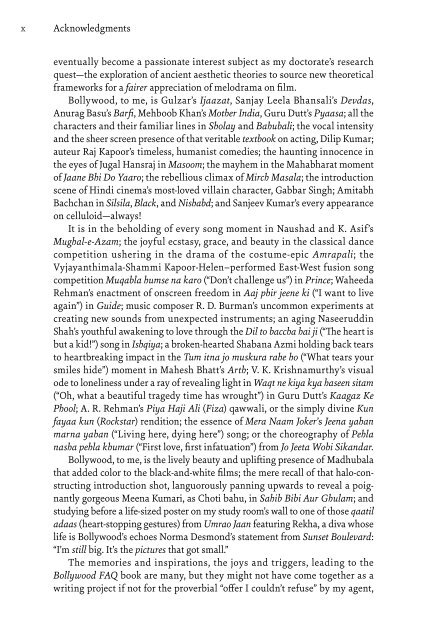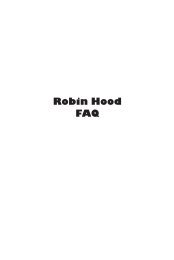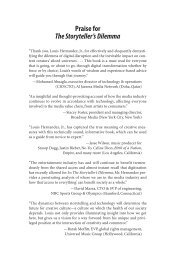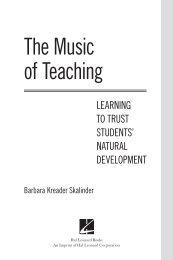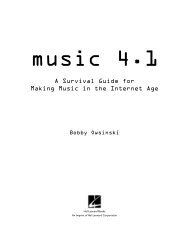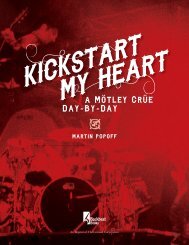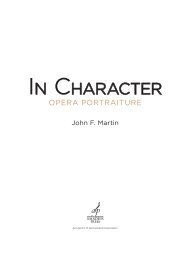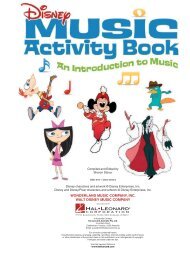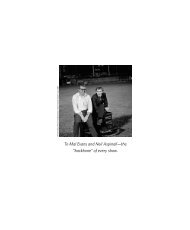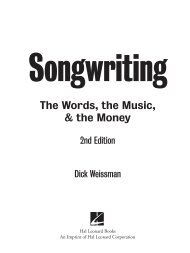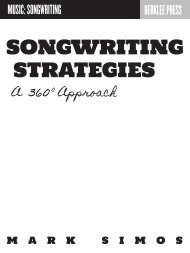- Page 1: Bollywood FAQ
- Page 4 and 5: Published by Applause Theatre & Cin
- Page 7 and 8: Contents Acknowledgments Introducti
- Page 9: Acknowledgments I have often been a
- Page 14 and 15: xiv Introduction films. The Indian
- Page 17: Section 1 History and Highlights
- Page 20 and 21: 4 Bollywood FAQ short, featuring vi
- Page 22 and 23: 6 Bollywood FAQ 9. 1932—J. J. Mad
- Page 24 and 25: 8 Bollywood FAQ of Dadasaheb Phalke
- Page 26 and 27: 10 Bollywood FAQ and Nargis, his le
- Page 28 and 29: 12 Bollywood FAQ Modern Art in New
- Page 30 and 31: 14 Bollywood FAQ cinema for its “
- Page 32 and 33: 16 Bollywood FAQ achieves a memorab
- Page 34 and 35: 18 Bollywood FAQ his movies in his
- Page 36 and 37: 20 Bollywood FAQ adaptation of Mada
- Page 38 and 39: 22 Bollywood FAQ film sets are recr
- Page 40 and 41: 24 Bollywood FAQ Bollywood,” the
- Page 42 and 43: 26 Bollywood FAQ film’s cameraman
- Page 44 and 45: 28 Bollywood FAQ The Role of Christ
- Page 46 and 47: 30 Bollywood FAQ drama. Of the 138
- Page 48 and 49: 32 Bollywood FAQ Even in a tale of
- Page 50 and 51: 3 The Rise of Bombay Cinema In a na
- Page 52 and 53: 36 Bollywood FAQ Phalke, serving as
- Page 54 and 55: 38 Bollywood FAQ subcontinent’s b
- Page 56 and 57: 40 Bollywood FAQ The Early Studios
- Page 58 and 59: 42 Bollywood FAQ A poster of Bombay
- Page 60 and 61:
44 Bollywood FAQ with his actress-w
- Page 62 and 63:
46 Bollywood FAQ The Rise and Conso
- Page 64 and 65:
48 Bollywood FAQ Talkies, Raj Kapoo
- Page 66 and 67:
50 Bollywood FAQ which, many leadin
- Page 68 and 69:
4 Breaking Ground Significant First
- Page 70 and 71:
54 Bollywood FAQ extensive exhibiti
- Page 72 and 73:
56 Bollywood FAQ Dattatraya Damodar
- Page 74 and 75:
58 Bollywood FAQ Fatma Begum. Phot
- Page 76 and 77:
60 Bollywood FAQ of the Lord . . .
- Page 78 and 79:
62 Bollywood FAQ been featured in a
- Page 80 and 81:
64 Bollywood FAQ 1933—First Color
- Page 82 and 83:
66 Bollywood FAQ 1938—First Use o
- Page 84 and 85:
68 Bollywood FAQ An elaborate court
- Page 86 and 87:
70 Bollywood FAQ 1952—The First I
- Page 88 and 89:
72 Bollywood FAQ film, along with a
- Page 90 and 91:
74 Bollywood FAQ 1967—First 70mm
- Page 92 and 93:
76 Bollywood FAQ 1996—First Film
- Page 94 and 95:
78 Bollywood FAQ 2000—First India
- Page 96 and 97:
80 Bollywood FAQ Hrithik Roshan as
- Page 98 and 99:
82 Bollywood FAQ 2015—First Two-P
- Page 100 and 101:
84 Bollywood FAQ of widely disparat
- Page 102 and 103:
86 Bollywood FAQ Ram, Lakshman, and
- Page 104 and 105:
88 Bollywood FAQ the highlight mome
- Page 106 and 107:
90 Bollywood FAQ first twenty-first
- Page 108 and 109:
92 Bollywood FAQ chunks of its popu
- Page 110 and 111:
94 Bollywood FAQ The Devotional The
- Page 112 and 113:
96 Bollywood FAQ for film plots is
- Page 114 and 115:
98 Bollywood FAQ in the Urdu langua
- Page 116 and 117:
100 Bollywood FAQ Romantic-triangle
- Page 118 and 119:
102 Bollywood FAQ choreographed cha
- Page 120 and 121:
104 Bollywood FAQ Must Watch: Woh K
- Page 122 and 123:
106 Bollywood FAQ The most popular
- Page 124 and 125:
108 Bollywood FAQ single film. This
- Page 126 and 127:
7 Trend-Spotting Down the Decades R
- Page 128 and 129:
112 Bollywood FAQ Early Talkies (19
- Page 130 and 131:
114 Bollywood FAQ color-coordinated
- Page 132 and 133:
116 Bollywood FAQ Bling is in, albe
- Page 134 and 135:
118 Bollywood FAQ Fusion/Tradition
- Page 137:
Section 2 Stars from Another Sky
- Page 140 and 141:
124 Bollywood FAQ pioneer culturatt
- Page 142 and 143:
126 Bollywood FAQ Sashadhar Mukherj
- Page 144 and 145:
128 Bollywood FAQ But differences i
- Page 146 and 147:
9 The “Fearless” Woman with the
- Page 148 and 149:
132 Bollywood FAQ “Fearless Nadia
- Page 150 and 151:
134 Bollywood FAQ the Machiavellian
- Page 152 and 153:
10 The Thespian of Good Acting I do
- Page 154 and 155:
138 Bollywood FAQ would affect my o
- Page 156 and 157:
140 Bollywood FAQ real-life convers
- Page 158 and 159:
142 Bollywood FAQ Marriage happened
- Page 160 and 161:
144 Bollywood FAQ “Villain” Pra
- Page 162 and 163:
146 Bollywood FAQ He added, “When
- Page 164 and 165:
148 Bollywood FAQ shares a complex
- Page 166 and 167:
150 Bollywood FAQ when she ate a pa
- Page 168 and 169:
152 Bollywood FAQ but she neither g
- Page 170 and 171:
154 Bollywood FAQ paradox it was th
- Page 172 and 173:
156 Bollywood FAQ Rajesh Khanna mad
- Page 174 and 175:
158 Bollywood FAQ in popularity wit
- Page 176 and 177:
160 Bollywood FAQ An ordinary man w
- Page 178 and 179:
162 Bollywood FAQ Gawah (God is Wit
- Page 180 and 181:
164 Bollywood FAQ Memories, 1973),
- Page 182 and 183:
166 Bollywood FAQ screen. With Yash
- Page 184 and 185:
168 Bollywood FAQ Best of Bachchan
- Page 186 and 187:
170 Bollywood FAQ Shah Rukh Khan an
- Page 188 and 189:
172 Bollywood FAQ religious harmony
- Page 190 and 191:
174 Bollywood FAQ all celebration a
- Page 192 and 193:
16 The Game Changer The moment you
- Page 194 and 195:
178 Bollywood FAQ has been India’
- Page 196 and 197:
180 Bollywood FAQ influential perce
- Page 198 and 199:
182 Bollywood FAQ Aamir Khan with h
- Page 200 and 201:
17 A Diva for All Seasons It’s ni
- Page 202 and 203:
186 Bollywood FAQ helmed by two aut
- Page 204 and 205:
188 Bollywood FAQ The consequence f
- Page 206 and 207:
190 Bollywood FAQ Aishwarya Rai wit
- Page 208 and 209:
192 Bollywood FAQ Beauty Queens to
- Page 210 and 211:
194 Bollywood FAQ and headlines for
- Page 212 and 213:
196 Bollywood FAQ gangster characte
- Page 214 and 215:
198 Bollywood FAQ Few Handsome Face
- Page 216 and 217:
200 Bollywood FAQ in the U.K. that
- Page 218 and 219:
202 Bollywood FAQ A leading Bollywo
- Page 220 and 221:
204 Bollywood FAQ Devika Rani and N
- Page 222 and 223:
206 Bollywood FAQ When I decided to
- Page 224 and 225:
208 Bollywood FAQ a stranger’s do
- Page 226 and 227:
210 Bollywood FAQ strategic escape,
- Page 228 and 229:
212 Bollywood FAQ Meena Shorey, wit
- Page 230 and 231:
214 Bollywood FAQ The “Teen Bride
- Page 232 and 233:
216 Bollywood FAQ Surprisingly, tho
- Page 234 and 235:
218 Bollywood FAQ enriched by the i
- Page 237:
Section 3 Songs, Dance, and Music M
- Page 240 and 241:
224 Bollywood FAQ and the performin
- Page 242 and 243:
226 Bollywood FAQ Within this fable
- Page 244 and 245:
228 Bollywood FAQ “I do not want
- Page 246 and 247:
230 Bollywood FAQ Kumar (Ziddi, Ada
- Page 248 and 249:
232 Bollywood FAQ these new sounds,
- Page 250 and 251:
234 Bollywood FAQ best-remembered s
- Page 252 and 253:
236 Bollywood FAQ out in her critic
- Page 254 and 255:
238 Bollywood FAQ Beyond 2000: The
- Page 256 and 257:
240 Bollywood FAQ manner of music v
- Page 258 and 259:
242 Bollywood FAQ “rubber-girl”
- Page 260 and 261:
244 Bollywood FAQ Jala do ise, phoo
- Page 262 and 263:
246 Bollywood FAQ Guide, a “hit
- Page 264 and 265:
248 Bollywood FAQ Aashiqui (Romance
- Page 266 and 267:
250 Bollywood FAQ Where cinema soug
- Page 268 and 269:
252 Bollywood FAQ Voice of India—
- Page 270 and 271:
254 Bollywood FAQ did so a decade l
- Page 272 and 273:
256 Bollywood FAQ Dev Anand essays
- Page 274 and 275:
258 Bollywood FAQ spring breeze, sh
- Page 276 and 277:
260 Bollywood FAQ to learn the Hind
- Page 278 and 279:
262 Bollywood FAQ Singers Mohammad
- Page 280 and 281:
264 Bollywood FAQ and its similarly
- Page 282 and 283:
266 Bollywood FAQ Must-Watch Dances
- Page 284 and 285:
268 Bollywood FAQ music. From roman
- Page 286 and 287:
270 Bollywood FAQ of the Incan city
- Page 288 and 289:
272 Bollywood FAQ Bay National Park
- Page 290 and 291:
274 Bollywood FAQ A poster depictin
- Page 292 and 293:
276 Bollywood FAQ acceptable to hav
- Page 294 and 295:
278 Bollywood FAQ Raat (A Rainy Nig
- Page 296 and 297:
280 Bollywood FAQ “Aha rimjhim ke
- Page 298 and 299:
282 Bollywood FAQ Patil immediately
- Page 301:
Section 4 The Lists
- Page 304 and 305:
288 Bollywood FAQ technically advan
- Page 306 and 307:
290 Bollywood FAQ with multiple win
- Page 308 and 309:
292 Bollywood FAQ Actor-director Gu
- Page 310 and 311:
294 Bollywood FAQ also helmed Guide
- Page 312 and 313:
296 Bollywood FAQ of class. This in
- Page 314 and 315:
298 Bollywood FAQ and horror films
- Page 316 and 317:
300 Bollywood FAQ Must Watch: Amar
- Page 318 and 319:
27 Class Acts Dancer-actress Waheed
- Page 320 and 321:
304 Bollywood FAQ Nargis in Mother
- Page 322 and 323:
306 Bollywood FAQ Meena Kumari in S
- Page 324 and 325:
308 Bollywood FAQ mid-way on his jo
- Page 326 and 327:
310 Bollywood FAQ Amitabh Bachchan
- Page 328 and 329:
312 Bollywood FAQ harried and “ex
- Page 330 and 331:
314 Bollywood FAQ Kamal Haasan as S
- Page 332 and 333:
316 Bollywood FAQ Wow Moment A matu
- Page 334 and 335:
318 Bollywood FAQ ■■ Aamir Khan
- Page 336 and 337:
320 Bollywood FAQ processed in a ma
- Page 338 and 339:
322 Bollywood FAQ 6. Duniya Na Mane
- Page 340 and 341:
324 Bollywood FAQ What is it about
- Page 342 and 343:
326 Bollywood FAQ Begum’s playful
- Page 344 and 345:
328 Bollywood FAQ place of their fa
- Page 346 and 347:
330 Bollywood FAQ shoot her own son
- Page 348 and 349:
332 Bollywood FAQ Indian courtroom
- Page 350 and 351:
334 Bollywood FAQ The characters of
- Page 352 and 353:
336 Bollywood FAQ 34. Haqeeqat (The
- Page 354 and 355:
338 Bollywood FAQ rich and the famo
- Page 356 and 357:
340 Bollywood FAQ 41. “Muqabla hu
- Page 358 and 359:
342 Bollywood FAQ 44. Anand (Joy, 1
- Page 360 and 361:
344 Bollywood FAQ and calls him to
- Page 362 and 363:
346 Bollywood FAQ Hindu-majority In
- Page 364 and 365:
348 Bollywood FAQ Vidya Sinha and A
- Page 366 and 367:
350 Bollywood FAQ 55. Aandhi (The B
- Page 368 and 369:
352 Bollywood FAQ (Left to right):
- Page 370 and 371:
354 Bollywood FAQ Kavita (Shabana A
- Page 372 and 373:
356 Bollywood FAQ Picturized on Kam
- Page 374 and 375:
358 Bollywood FAQ cinema icon Smita
- Page 376 and 377:
360 Bollywood FAQ 71. Ijaazat (Perm
- Page 378 and 379:
362 Bollywood FAQ The longest item
- Page 380 and 381:
364 Bollywood FAQ Shah Rukh Khan as
- Page 382 and 383:
366 Bollywood FAQ 84. Lagaan (Land
- Page 384 and 385:
368 Bollywood FAQ juxtaposed the pi
- Page 386 and 387:
370 Bollywood FAQ 94. 3 Idiots (200
- Page 388 and 389:
372 Bollywood FAQ 98. Barfi! (2012)
- Page 390 and 391:
374 Bollywood FAQ taking over from
- Page 392 and 393:
376 Bibliography Kabir, Nasreen Mun
- Page 394 and 395:
378 Bibliography Nugent, Frank S. 1
- Page 396 and 397:
380 Index Anmol Ghadi Anwar Anwar,
- Page 398 and 399:
382 Index Chalte Chalte Chaman Cham
- Page 400 and 401:
384 Index Fitzgerald, F. Scott Flah
- Page 402 and 403:
386 Index Judwaa Jugnu Julie Julka,
- Page 404 and 405:
388 Index Liguoro, Eugenio de Liguo
- Page 406 and 407:
390 Index Nargis Narayan, R. K. Nat
- Page 408 and 409:
392 Index Rashoman Rathod, Kajibhai
- Page 410 and 411:
394 Index Singh, Suchet Singh, Sukh


